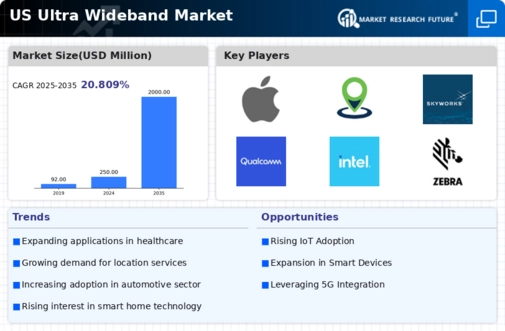Emergence of Wearable Technology
The emergence of wearable technology is significantly impacting the ultra wideband market. As fitness trackers, smartwatches, and health monitoring devices gain popularity, the need for efficient communication protocols becomes essential. Ultra wideband technology offers low latency and high accuracy, which are crucial for applications such as health monitoring and fitness tracking. The wearable technology market is expected to grow to $60 billion by 2025, with ultra wideband likely to play a key role in enhancing device performance. This trend suggests that the ultra wideband market will continue to evolve, providing innovative solutions that cater to the specific needs of wearable technology users.
Advancements in Location-Based Services
The ultra wideband market is witnessing advancements in location-based services, which are becoming increasingly critical across various sectors. This technology enables precise indoor positioning and tracking, with accuracy levels reaching within 10 cm. Industries such as retail, logistics, and healthcare are leveraging ultra wideband for applications like asset tracking and customer engagement. The market for location-based services is expected to grow substantially, with estimates suggesting a potential increase of over 30% in the next few years. As businesses recognize the value of accurate location data, the ultra wideband market is likely to expand, providing innovative solutions that enhance operational efficiency and customer experiences.
Integration with Smart Home Technologies
The integration of ultra wideband technology with smart home systems is driving growth in the ultra wideband market. As consumers increasingly adopt smart home devices, the demand for reliable and secure communication protocols rises. Ultra wideband offers advantages such as low power consumption and high data rates, making it an ideal choice for smart home applications. The market for smart home devices is projected to reach $174 billion by 2025, with ultra wideband playing a pivotal role in ensuring seamless connectivity among devices. This trend indicates that the ultra wideband market is well-positioned to capitalize on the growing smart home ecosystem, as manufacturers seek to enhance device interoperability and user experience.
Rising Demand for High-Speed Connectivity
The ultra wideband market is experiencing a notable surge in demand for high-speed connectivity solutions. As consumers increasingly rely on seamless data transfer for various applications, the need for ultra wideband technology becomes more pronounced. This technology offers data rates exceeding 1 Gbps, which is essential for applications such as video streaming and online gaming. According to recent estimates, the market is projected to grow at a CAGR of approximately 25% over the next five years. This growth is driven by the proliferation of smart devices and the Internet of Things (IoT), which require robust connectivity solutions. Consequently, the ultra wideband market is poised to benefit significantly from this trend, as manufacturers and service providers seek to meet the escalating demands of consumers for faster and more reliable connectivity.
Regulatory Support for Wireless Technologies
Regulatory support for wireless technologies is fostering growth in the ultra wideband market. The Federal Communications Commission (FCC) has established guidelines that promote the use of ultra wideband technology, particularly in applications such as automotive safety and telecommunications. This regulatory framework encourages innovation and investment in the ultra wideband market, as companies seek to develop compliant solutions that meet the evolving needs of consumers. With the increasing focus on safety and efficiency in various sectors, the ultra wideband market is likely to benefit from favorable regulations that support its adoption and integration into new applications.






















Leave a Comment